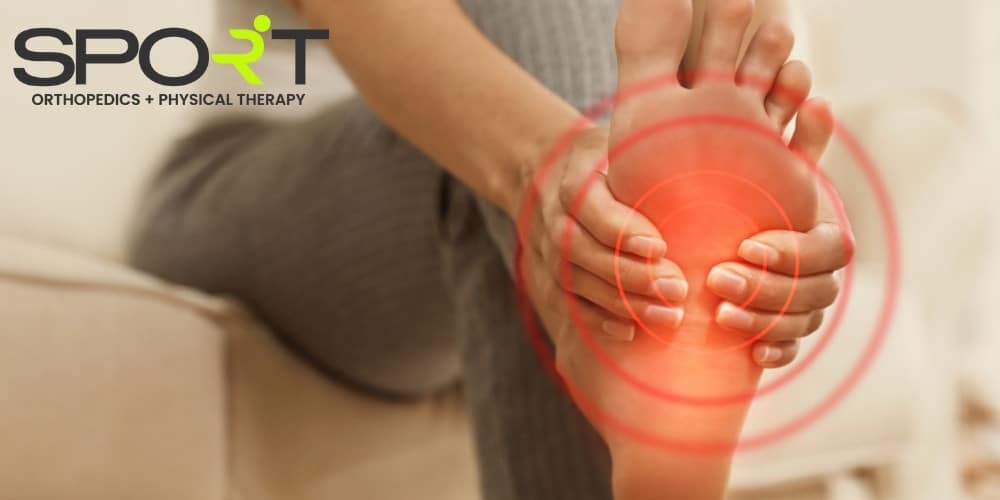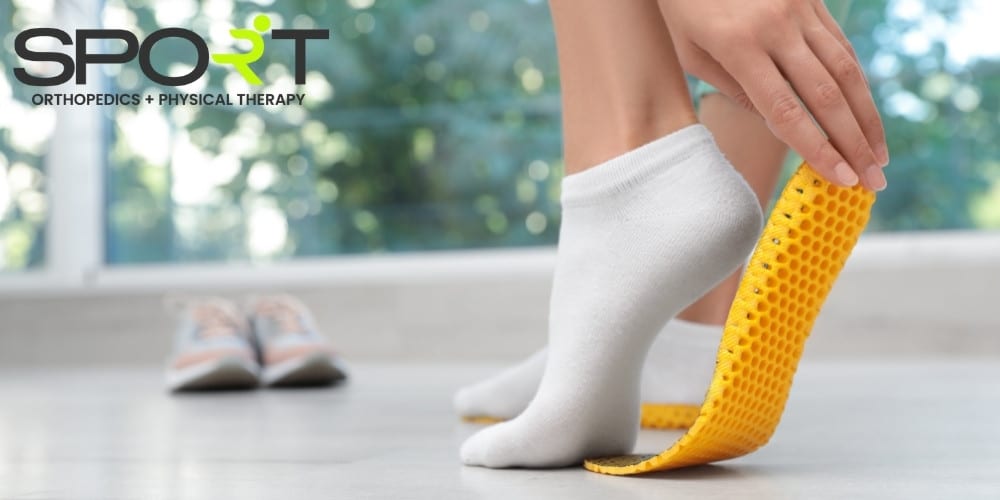
Running is an effective and inexpensive way to get in your daily exercise, but it’s also a hobby for many people. Rather than participating in a sport that requires expensive equipment, you only need a pair of running shoes to really enjoy running. However, like many other physical activities, running can either cause foot pain on its own or aggravate an existing condition, which then leads to foot pain. If you find yourself wondering, “Why do my feet hurt when I run?”, this blog post is for you.
At SPORT Orthopedics + Physical Therapy, we take great pride in ensuring that our patients receive top-notch care and only the best available treatments. Whether you’re new to running or you’re a seasoned runner, foot injuries and foot pain are always a possibility. If you suffer from foot pain, toe pain, heel pain, ankle joint pain, or tight calf muscles, we have solutions for you. To schedule an appointment with the best Dallas orthopedic surgeons, please call our office at 469-200-2832 today.

Certain athletes and hobbyists are more prone to certain injuries and physical ailments. For example, dancers are prone to dancer’s hip, tennis players can get tennis elbow, swimmers can get swimmer's shoulder, and golfers can get golfer's elbow. When it comes to runners, they often suffer from the following foot conditions.
This is far from an exhaustive list of the conditions and foot injuries that runners suffer from, but we see the above cases frequently in runners. If you are a runner who suffers from an extremely painful foot condition, we’re here to help.

In this section, we outline several common causes of foot pain in runners, as well as our treatment options for those conditions. Whether you run regularly or rarely, it is possible to develop any of the following conditions or injuries while running.
This condition is one of the most common sources of foot and heel pain in runners. When the plantar fascia, a thick band of tissue that runs along the bottom of your foot, becomes inflamed, it produces stabbing or burning pain. This is what we call plantar fasciitis. Runners and those who are overweight are more likely to suffer from this condition. It develops due to the repeated stress placed on the plantar fascia, which causes microscopic tears in the tough tissue.
Plantar fasciitis is generally treated with conservative, non-surgical methods. Your doctor may recommend that you begin with over-the-counter pain medication. Other conservative treatment options involve seeing a physical therapist, wearing foot splints at night, wearing shoes with enough arch support, or getting custom orthotics. If these methods fail to relieve your pain, we may then opt for plantar fasciitis injections, tissue repair, or surgery as a last resort.
Pes cavus is more of a structural problem with the foot, rather than a foot condition. It is what we commonly call a high foot arch. When the structure of the foot does not flatten when it bears weight, this is pes cavus. It can cause pain and discomfort if you do not wear supportive shoes.
Generally, treatment for pes cavus involves wearing running shoes that adequately support the foot, wearing custom orthotics, and taking pain medication as needed. You can also undergo physical therapy if you are feeling post-run pain that you can’t seem to get rid of.
Pes planus is what we commonly call flat feet. Although it is technically a foot deformity, it rarely causes significant problems for those with flat feet. For those who suffer pain or discomfort from their flat feet, treatments often involve custom orthotics, visiting a physical therapist, pain medication, and modifying your activities to avoid irritation of the foot arches.
Otherwise known as turf toe or a stiff big toe, hallux rigidus is basically arthritis of the big toe joint. It can cause significant pain and stiffness in the big toe joint if left untreated. This condition is not synonymous with hallux valgus, also known as bunions.
To treat hallux rigidus, we will encourage the patient to wear correct running shoes that have plenty of room in the front for the toes. You can also use toe pads to reduce the movement of your big toe while you run. Other treatment options include OTC pain medications, foot soaks, and steroid injections.
Tiny fractures in the bones of the feet that occur when too much pressure is applied are called stress fractures. They are often classified as overuse injuries, as they tend to occur when repeated stress is applied to the foot. Repeatedly jumping and running for long distances can cause a stress fracture in the foot.
To treat a stress fracture, we may recommend that you wear a walking boot or a foot brace for a few weeks. This will help take the load off of your foot so that the stress fracture can heal properly. Stress fractures rarely need surgery, but those in areas of the body with poor blood flow are more likely to require surgery.
If you have pain on the ball of your foot, you might have metatarsalgia. This condition can cause burning or sharp pain in the foot, especially for those who wear improper running shoes with too little room in them. Treatment usually involves wearing cushioned shoes with plenty of arch support, wearing custom-made orthotics, and resting the affected foot. Only rare cases of metatarsalgia require surgery.
This condition mostly affects the ball of the foot, between the third and fourth toes. Many people describe it as feeling like you’re standing on a rock in your shoe. When the tissue around one of the nerves in your foot begins to thicken, this is what causes Morton’s neuroma. It often produces pain at the pressure point on your foot.
In most cases, Morton’s neuroma can be treated by wearing roomier shoes with no heels. If this does not fully resolve the problem, your doctor can administer corticosteroid injections into the area.
When the fat pad that surrounds your heel bone begins to thin out, this is called fat pad syndrome. Certain activities, as well as prolonged walking and standing, can lead to this problem. Frequently walking without shoes (barefoot) can also cause fat pad syndrome.
Treatments for this condition usually include the RICE method (rest, ice, compression, elevation), wearing a proper running shoe, pain medication, orthotics, and heel taping. If these conservative methods fail to solve the problem, your doctor may try fillers or fat grafting.
This is another overuse injury that occurs to the Achilles tendon. The Achilles tendon is the strong band of tissue that connects your heel bone to your calf muscles. Keep in mind that tendonitis can occur to any of the tendons in the foot, including the foot extensor tendons. Achilles tendonitis is more well-known than the other forms of tendonitis in the foot.
To treat Achilles tendonitis, your doctor will initially recommend pain relievers, ankle strengthening exercises, or even orthotics. If the Achilles tendon has torn, or if your symptoms persist, your doctor may recommend a tendon repair surgery.
If you’ve ever rolled your ankle or twisted it in an awkward way, then felt a dull pain, you’ve experienced a mild ankle sprain. Mild sprains only stretch the ligaments in the foot, while serious sprains can actually tear them. Your doctor will base their treatment plan on the severity of your injury.
For mild sprains, you may need to take pain medications and apply the RICE method. If walking is painful, you can use crutches until the pain subsides. We usually recommend ankle strengthening exercises in order to prevent recurrent sprains. If the sprain is very severe, or if it does not heal or stabilize, we may recommend ligament repair or reconstruction.
Even calf muscle injuries can cause pain in your foot. If you pull, stretch or tear your calf muscle, your treatment will likely begin with the RICE method, plus pain management. While your injury heals, we recommend using crutches or another assistive device. For milder injuries, we usually recommend physical therapy.
For more serious calf injuries, surgery may be necessary. After the surgery, you will wear a cast on your leg for about three weeks. This is followed by a gradual return to physical activity, as well as physical therapy.

When you seek medical advice about your foot pain, your doctor will likely begin by asking about your symptoms and your medical history, then performing a physical exam. We can also perform certain tests that allow us to assess the stability of your ligaments and other tissues. If we suspect an injury to your bone, we will likely order an x-ray, a CT scan, an ultrasound, and even blood tests.
In order to properly diagnose your foot pain, we will first pinpoint the location of the pain. Below, we outline the different sections of the foot, as well as the common conditions associated with each.
Foot pain at the outer edge of the foot is usually either a Jones fracture or an avulsion fracture.

If you’re already an avid runner, or if you’d like to try running, we have a few tips to help you prevent plantar fasciitis, stress fractures, and many of the other conditions we discussed above.

If you suffer from foot pain during or after a run, the orthopedic specialists at SPORT Orthopedics + Physical Therapy are here for you. Our Dallas orthopedic surgeons treat countless cases of foot pain every year, so we have an immense amount of experience under our belts. To schedule an appointment with our doctors and physical therapists in Dallas, please call our office at 469-200-2832 today.









*We accept most all insurance plans, if you do not see your plan listed above or have any questions, please contact our office.

SPORT Orthopedics + Physical
Therapy – Dallas, TX
Services:
• Clinic • Orthopedic • Urgent Care
• Physical Therapy
18152 Preston Road
Suite I-2
Dallas, TX 75252
Phone: (469) 200-2832
Fax: (469) 269-1074
SPORT Orthopedics + Physical Therapy – Frisco, TX
Services:
• Clinic • Orthopedic • Urgent Care
• Physical Therapy
9255 Dallas Parkway
Suite I20
Frisco, TX 75033
Phone: (469) 200-2832
Fax: (469) 269-1074
SPORT Orthopedics + Physical
Therapy – Wylie, TX
Services:
• Clinic • Orthopedic • Urgent Care
• Physical Therapy
3400 FM 544
Suite 650
Wylie, TX 75098
Phone: (469) 200-2832
Fax: (469) 269-1074
SPORT Physical
Therapy – Prosper, TX
Services:
• Physical Therapy
790 N Preston Rd
Suite 60
Prosper, TX 75078
Phone: (469) 850-0201
Fax: (469) 269-1074
SPORT Orthopedics – Mesquite, TX
Services:
• Clinic
• Orthopedic
• Urgent Care
1102 North Galloway Ave
Mesquite, TX 75149
Phone: (469) 200-2832
Fax: (469) 269-1074